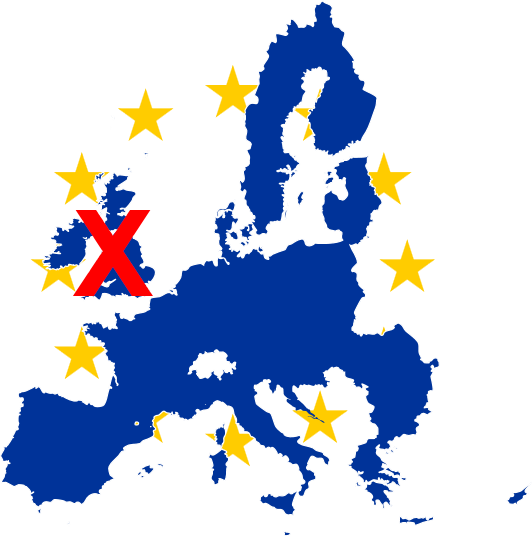 With the Conservatives having lost their majority in Parliament in the recent UK election, there is renewed discussion of the form that Brexit might take. EU states are members of the single market and the customs union. A ‘hard Brexit’ involves leaving both and this was the government’s stance prior to the election. But there is now talk of a softer Brexit, which might mean retaining membership of the single market and/or customs union.
With the Conservatives having lost their majority in Parliament in the recent UK election, there is renewed discussion of the form that Brexit might take. EU states are members of the single market and the customs union. A ‘hard Brexit’ involves leaving both and this was the government’s stance prior to the election. But there is now talk of a softer Brexit, which might mean retaining membership of the single market and/or customs union.
The single market
Belonging to the single market means accepting the free movement of goods, services, capital and labour. It also involves tariff-free trade within the single market and adopting a common set of rules and regulations over trade, product standards, safety, packaging, etc., with disputes settled by the European Court of Justice. Membership of the single market involves paying budgetary contributions. Norway and Iceland are members of the single market.
The single market brings huge benefits from free trade with no administrative barriers from customs checks and paperwork. But it would probably prove impossible to negotiate remaining in the single market with an opt out on free movement of labour. Controlling immigration from EU countries was a key part of the Leave campaign.
The customs union
This involves all EU countries adopting the same tariffs (customs duties) on imports from outside the EU. These tariffs are negotiated by the European Commission with non-EU countries  on a country-by-country basis. Goods imported from outside the EU are charged tariffs in the country of import and can then be sold freely around the EU with no further tariffs.
on a country-by-country basis. Goods imported from outside the EU are charged tariffs in the country of import and can then be sold freely around the EU with no further tariffs.
Remaining a member of the customs union would allow the UK to continue trading freely in the EU, subject to meeting various non-tariff regulations. It would also allow free ‘borderless’ trade between Northern Ireland and the Republic of Ireland. However, being a member of the customs union would prevent the UK from negotiating separate trade deals with non-EU countries. The ability to negotiate such deals has been argued to be one of the main benefits of leaving the EU.
Free(r) trade area
The UK could negotiate a trade deal with the EU. But it is highly unlikely that such a deal could be in place by March 2019, the date when the UK is scheduled to leave the EU. At that point, trade barriers would be imposed, including between the two parts of the island of Ireland. Such deals are very complex, especially in the area of services, which are the largest category of UK exports. Negotiating tariff-free or reduced-tariff trade is only a small part of the problem; the biggest part involves negotiating product standards, regulations and other non-tariff barriers.
All the above options thus involve serious problems and the government will be pushed from various sides, not least within the Conservative Party, for different degrees of ‘softness’ or ‘hardness’ of Brexit. What is more, the pressure from business for free trade with the EU is likely to grow. Brexit may mean Brexit, but just what form it will take is very unclear.
Articles
Free trade area, single market, customs union – what’s the difference? BBC News, Jonty Bloom (12/6/17)
Brexit: What are the options? BBC News (12/6/17)
After the election, the real test: Brexi The Economist (8/6/17)
May’s Ministers Plot Softer Brexit to Keep UK in Single Market Bloomberg, Tim Ross, Alex Morales and Svenja O’Donnell (11/6/17)
UK’s Hung Parliament Raises Business Hopes for a Softer Brexit Bloomberg, Stephanie Baker and James Paton (12/6/17)
Do not exaggerate the effect the election will have on Brexit Financial Times, Wolfgang Münchau (11/6/17)
What is soft Brexit? How could it work as UK negotiates leaving the EU? Independent, May Bulman (12/6/17)
Brexit-lite back on the table as Britain rethinks its options after election The Guardian, Dan Roberts (11/6/17)
Review plan to quit EU Customs Union, urges FTA FoodManufacture.co.uk, James Ridler (12/6/17)
Freight leaders urge government to review decision to leave EU customs union RTM (12/6/17)
Paper
Making Brexit work for British Business: Key Execution Priorities M-RCBG Associate Working Paper No. 77, Harvard Kennedy School, Peter Sands, Ed Balls, Sebastian Leape and Nyasha Weinberg (June 2017)
Questions
- Explain the trading agreement between Norway and the EU.
- How does the Norwegian arrangement with the EU differ from the Turkish one?
- What are meant by the terms ‘hard Brexit’ and ‘soft Brexit’?
- How does a customs union differ from a free trade area?
- Is it possible to have (a) a customs union without a single market; (b) a single market without a customs union?
- To what extent is it in the EU’s interests to negotiate a deal with the UK which lets it maintain access to the customs union without having free movement of labour?
- The EU insists that talks about future trading arrangements between the UK and the EU can take place only after sufficient progress has been made on the terms of the ‘divorce’. What elements are included in the divorce terms?
- If agreement is not reached by 29 March 2019, what happens and what would be the consequences?
- Will a hung parliament, or at least a government supported by the DUP on a confidence and supply basis, make it more or less likely that there will be a hard Brexit?
- For what reasons may the EU favour (a) a hard Brexit; (b) a soft Brexit?
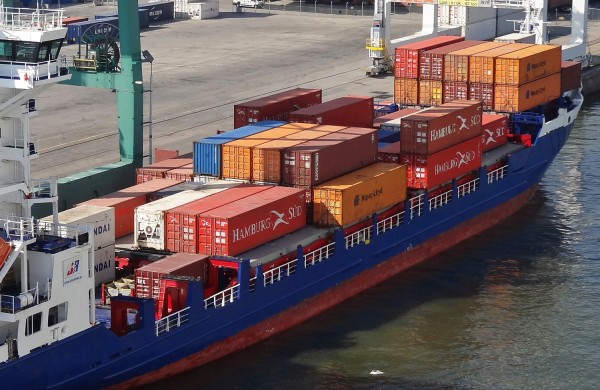 One of President Trump’s main policy slogans has been ‘America first’. As Trump sees it, a manifestation of a country’s economic strength is its current account balance. He would love the USA to have a current account surplus. As it is, it has the largest current account deficit in the world (in absolute terms) of $481 billion in 2016 or 2.6% of GDP. This compares with the UK’s $115bn or 4.4% of GDP. Germany, by contrast, had a surplus in 2016 of $294bn or 8.5% of GDP.
One of President Trump’s main policy slogans has been ‘America first’. As Trump sees it, a manifestation of a country’s economic strength is its current account balance. He would love the USA to have a current account surplus. As it is, it has the largest current account deficit in the world (in absolute terms) of $481 billion in 2016 or 2.6% of GDP. This compares with the UK’s $115bn or 4.4% of GDP. Germany, by contrast, had a surplus in 2016 of $294bn or 8.5% of GDP.
However, he looks at other countries’ current account surpluses suspiciously – they may be a sign, he suspects, of ‘unfair play’. Germany’s surplus of over $50bn with the USA is particularly in his sights. Back in January, as President-elect, he threatened to put a 35% tariff on imports of German cars.
In practice, Germany is governed by eurozone rules, which prevent it from subsidising exports. And it does not have its own currency to manipulate. What is more, it is relatively open to imports from the USA. The EU imposes an average tariff of just 3% on US imports and importers also have to add VAT (19% in the case of Germany) to make them comparably priced with goods produced within the EU.
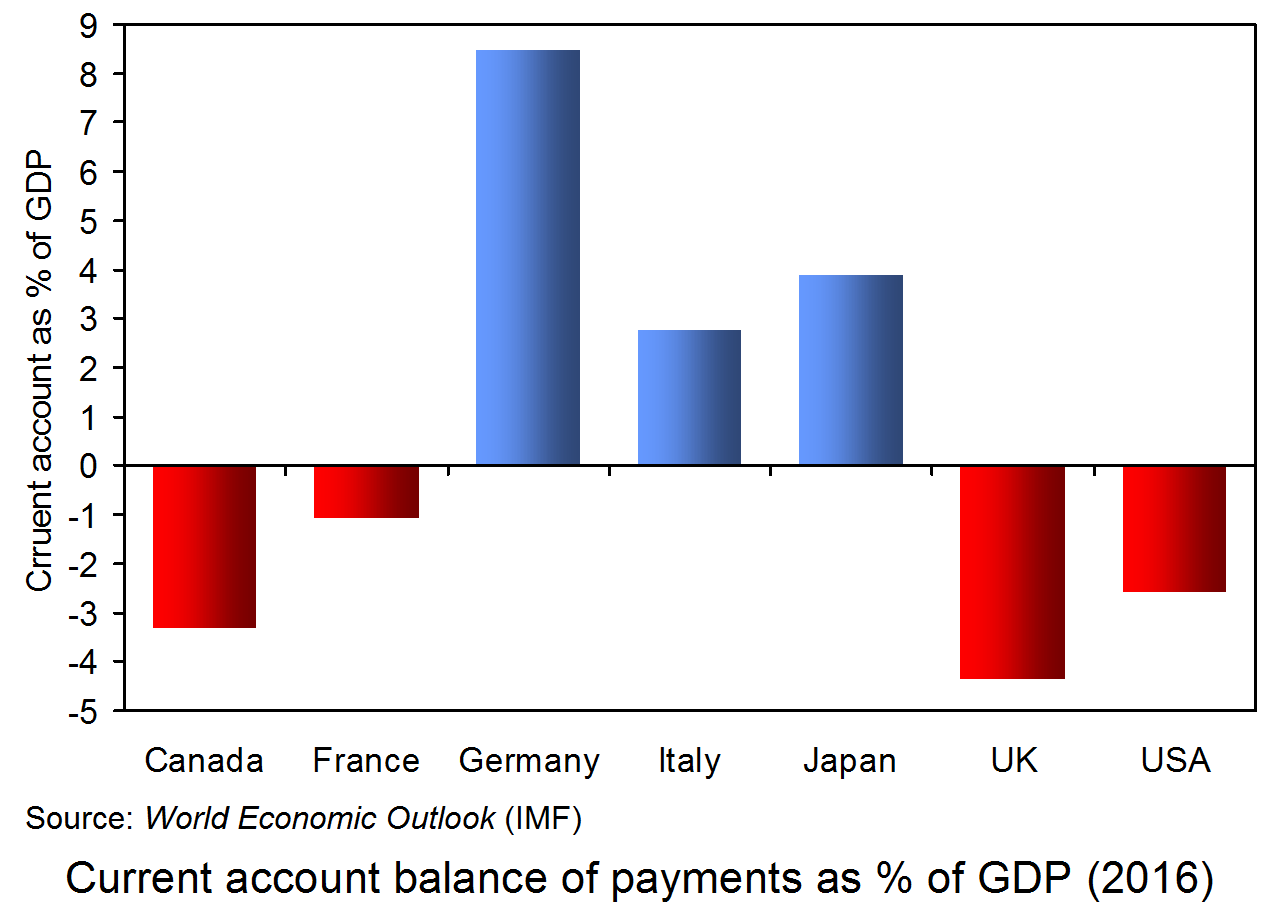 So why does Germany have such a large current account surplus? The article below explores the question and dismisses the claim that it’s the result of currency manipulation or discrimination against imports. The article states that the reason for the German surplus is that:
So why does Germany have such a large current account surplus? The article below explores the question and dismisses the claim that it’s the result of currency manipulation or discrimination against imports. The article states that the reason for the German surplus is that:
… it saves more than it invests. The correspondence of savings minus investment with exports minus imports is not an economic theory; it’s an accounting identity. Germans collectively spend less than they produce, and the difference necessarily shows up as net exports.
But why do the Germans save so much? The answer given is that, with an aging population, Germans are sensibly saving now to support themselves in old age. If Germany were to reduce its current account surplus, this would entail either the government reducing its budget surplus, or people reducing the amount they save, or some combination of the two. This is because a current account surplus, which consists of exports and other incomes from abroad (X) minus imports and any other income flowing abroad (M), must equal the surplus of saving (S) plus taxation (T) over investment (I) plus government expenditure (G). In terms of withdrawals and injections, given that:
I + G + X = S + T + M
 then, rearranging the terms,
then, rearranging the terms,
X – M = (S + T) – (I + G).
If German people are reluctant to reduce the amount they save, then an alternative is for the German government to reduce taxation or increase government expenditure. In the run-up to the forthcoming election on 24 September, Chancellor Merkel’s centre-right CDU party advocates cutting taxes, while the main opposition party, the SPD, advocates increasing government expenditure, especially on infrastructure. The article considers the arguments for these two approaches.
Article
The German economy is unbalanced – but Trump has the wrong answer The Guardian, Barry Eichengreen (12/5/17)
Data
German economic data (in English) Statistisches Bundesamt (Federal Statistical Office)
World Economic Outlook Databases IMF
Questions
- Why does Germany have such a large current account surplus?
- What are the costs and benefits to Germany of having a large current account surplus?
- What is meant by ‘mercantilism’? Why is its justification fallacious?
- If Germany had its own currency, would it be a good idea for it to let that currency appreciate?
- What are meant by ‘resource crowding out’ and ‘financial crowding out’? Why might the policies of tax cuts advocated by the CDU result in crowding out? What form would it take and why?
- Compare the relative benefits of the policies advocated by the CDU and SPD to reduce Germany’s budget surplus.
- Would other countries, such as the USA, benefit from a reduction in Germany’s current account surplus?
- Is what ways would the USA gain and lose from restricting imports from Germany? Would it be a net gain or loss? Explain.
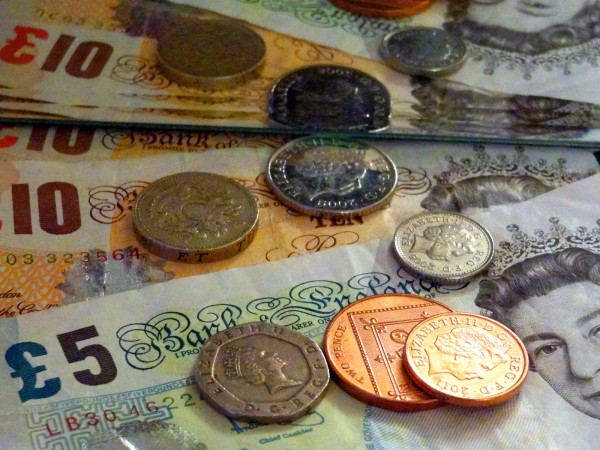 The latest figures from the ONS show that UK inflation rose to 2.3% for the 12 months to February 2017 – up from 1.9% for the 12 months to January. The rate is the highest since September 2013 and has steadily increased since late 2015.
The latest figures from the ONS show that UK inflation rose to 2.3% for the 12 months to February 2017 – up from 1.9% for the 12 months to January. The rate is the highest since September 2013 and has steadily increased since late 2015.
The main price index used to measure inflation is now CPIH, as opposed to CPI. CPIH is the consumer prices index (CPI) adjusted for housing costs and is thus a more realsitic measure of the cost pressures facing households. As the ONS states:
CPIH extends the consumer prices index (CPI) to include a measure of the costs associated with owning, maintaining and living in one’s own home, known as owner occupiers’ housing costs (OOH), along with Council Tax. Both of these are significant expenses for many households and are not included in the CPI.
But why has inflation risen so significantly? There are a number of reasons.
 The first is a rise in transport costs (contributing 0.15 percentage points to the overall inflation rate increase of 0.4 percentage points). Fuel prices rose especially rapidly, reflecting both the rise in the dollar price of oil and the depreciation of the pound. In February 2016 the oil price was $32.18; in February 2017 it was $54.87 – a rise of 70.5%. In February 2016 the exchange rate was £1 = $1.43; in February 2017 it was £1 = $1.25 – a depreciation of 12.6%.
The first is a rise in transport costs (contributing 0.15 percentage points to the overall inflation rate increase of 0.4 percentage points). Fuel prices rose especially rapidly, reflecting both the rise in the dollar price of oil and the depreciation of the pound. In February 2016 the oil price was $32.18; in February 2017 it was $54.87 – a rise of 70.5%. In February 2016 the exchange rate was £1 = $1.43; in February 2017 it was £1 = $1.25 – a depreciation of 12.6%.
The second biggest contributor to the rise in inflation was recreation and culture (contributing 0.08 percentage points). A wide range of items in this sector, including both goods and services, rose in price. ‘Notably, the price of personal computers (including laptops and tablets) increased by 2.3% between January 2017 and February 2017.’ Again, a large contributing factor has been the fall in the value of the pound. Apple, for example, raised its UK app store prices by a quarter in January, having raised prices for iPhones, iPads and Mac computers significantly last autumn. Microsoft has raised its prices by more than 20% this year for software services such as Office and Azure. Dell, HP and Tesla have also significantly raised their prices.
The third biggest was food and non-alcoholic beverages (contributing 0.06 percentage points). ‘Food prices, overall, rose by 0.8% between January 2017 and February 2017, compared with a smaller rise of 0.1% a year earlier.’ Part of the reason has been the fall in the pound, but part has been poor harvests in southern Europe putting up euro prices. This is the first time that overall food prices have risen for more than two-and-a-half years.
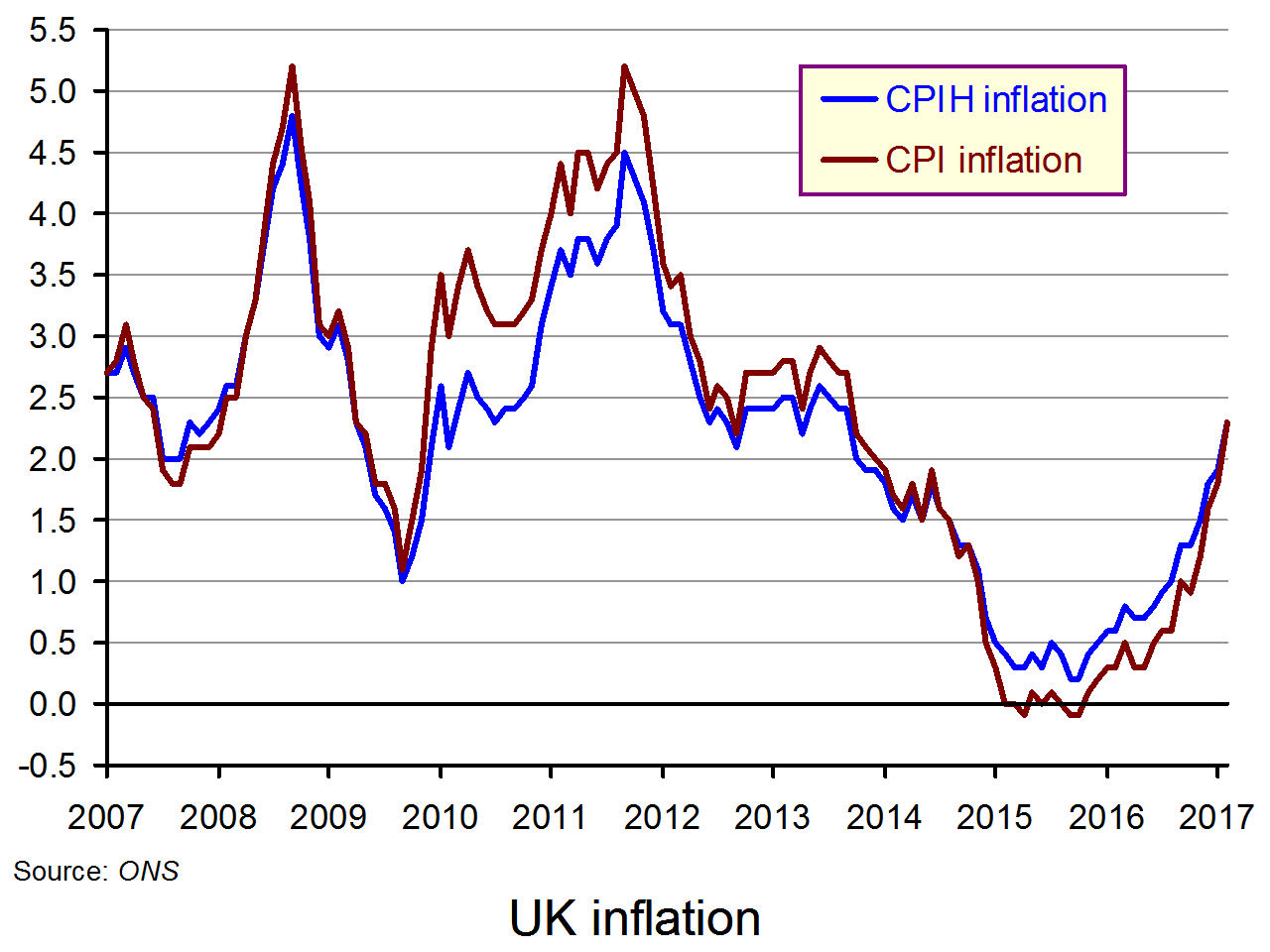 It is expected that inflation will continue to rise over the coming months as the effect of the weaker pound and higher raw material and food prices filter though. The current set of pressures could see inflation peaking at around 3%. If there is a futher fall in the pound or further international price increases, inflation could be pushed higher still – well above the Bank of England’s 2% target. (Click here for a PowerPoint of the chart.)
It is expected that inflation will continue to rise over the coming months as the effect of the weaker pound and higher raw material and food prices filter though. The current set of pressures could see inflation peaking at around 3%. If there is a futher fall in the pound or further international price increases, inflation could be pushed higher still – well above the Bank of England’s 2% target. (Click here for a PowerPoint of the chart.)
The higher inflation means that firms are facing a squeeze on their profits from two directions.
First, wage rises have been slowing and are now on a level with consumer price rises. It is likely that wage rises will soon drop below price rises, meaning that real wages will fall, putting downward pressure on spending and squeezing firms’ revenue.
Second, input prices are rising faster than consumer prices. In the 12 months to February 2017, input prices (materials and fuels) rose by 19.1%, putting a squeeze on producers. Producer prices (‘factory gate prices’), by contrast, rose by 3.7%. Even though input prices are only part of the costs of production, the much smaller rise of 3.7% reflects the fact that producer’s margins have been squeezed. Retailers too are facing upward pressure on costs from this 3.7% rise in the prices of products they buy from producers.
One of the worries about the squeeze on real wages and the squeeze on profits is that this could dampen investment and slow both actual and potential growth.
 So will the Bank of England respond by raising interest rates? The answer is probably no – at least not for a few months. The reason is that the higher inflation is not the result of excess demand and the economy ‘overheating’. In other words, the higher inflation is not from demand-pull pressures. Instead, it is from higher costs, which are in themselves likely to dampen demand and contribute to a slowdown. Raising interest rates would cause the economy to slow further.
So will the Bank of England respond by raising interest rates? The answer is probably no – at least not for a few months. The reason is that the higher inflation is not the result of excess demand and the economy ‘overheating’. In other words, the higher inflation is not from demand-pull pressures. Instead, it is from higher costs, which are in themselves likely to dampen demand and contribute to a slowdown. Raising interest rates would cause the economy to slow further.
Videos
 UK inflation shoots above two percent, adding to Bank of England conundrum Reuters, William Schomberg, David Milliken and Richard Hunter (21/3/17)
UK inflation shoots above two percent, adding to Bank of England conundrum Reuters, William Schomberg, David Milliken and Richard Hunter (21/3/17)
 Bank target exceeded as inflation rate rises to 2.3% ITV News, Chris Choi (21/3/17)
Bank target exceeded as inflation rate rises to 2.3% ITV News, Chris Choi (21/3/17)
 Steep rise in inflation Channel 4 News, Siobhan Kennedy (21/3/17)
Steep rise in inflation Channel 4 News, Siobhan Kennedy (21/3/17)
 U.K. Inflation Gains More Than Forecast, Breaching BOE Goal Bloomberg, Dan Hanson and Fergal O’Brien (21/3/17)
U.K. Inflation Gains More Than Forecast, Breaching BOE Goal Bloomberg, Dan Hanson and Fergal O’Brien (21/3/17)
Articles
Inflation leaps in February raising prospect of interest rate rise The Telegraph, Julia Bradshaw (21/3/17)
Brexit latest: Inflation jumps to 2.3 per cent in February Independent, Ben Chu (21/3/17)
UK inflation rate leaps to 2.3% BBC News (21/3/17)
UK inflation: does it matter for your income, debts and savings? Financial Times, Chris Giles (21/3/17)
Rising food and fuel prices hoist UK inflation rate to 2.3% The Guardian, Katie Allen (21/3/17)
Reality Check: What’s this new measure of inflation? BBC News (21/3/17)
Data
UK consumer price inflation: Feb 2017 ONS Statistical Bulletin (21/3/17)
UK producer price inflation: Feb 2017 ONS Statistical Bulletin (21/3/17)
Inflation and price indices ONS datasets
Consumer Price Inflation time series dataset ONS datasets
Producer Price Index time series dataset ONS datasets
European Brent Spot Price US Energy Information Administration
Statistical Interactive Database – interest & exchange rates data Bank of England
Questions
- If pries rise by 10% and then stay at the higher level, what will happen to inflation (a) over the next 12 months; (b) in 13 months’ time?
- Distinguish between demand-pull and cost-push inflation. Why are they associated with different effects on output?
- If producers face rising costs, what determines their ability to pass them on to retailers?
- Why is the rate of real-wage increase falling, and why may it beome negative over the coming months?
- What categories of people are likely to lose the most from inflation?
- What is the Bank of England’s remit in terms of setting interest rates?
- What is likely to affect the sterling exchange rate over the coming months?
 Economists were generally in favour of the UK remaining in the EU and highly critical of the policy proposals of Donald Trump. And yet the UK voted to leave the EU and Donald Trump was elected.
Economists were generally in favour of the UK remaining in the EU and highly critical of the policy proposals of Donald Trump. And yet the UK voted to leave the EU and Donald Trump was elected.
People rejected the advice of most economists. Many blamed the failure of most economists to predict the 2007/8 financial crisis and to find solutions to the growing gulf between rich and poor, with the majority stuck on low incomes.
So to what extent are economists to blame for the rise in populism – a wave that could lead to electoral upsets in various European countries? The podcast below brings together economists and politicians from across the political spectrum. It is over an hour long and provides an in-depth discussion of many of the issues and the extent to which economists can provide answers.
Podcast
 Should economists share the blame for populism? Guardian Politics Weekly podcast, Heather Stewart, joined by Andrew Lilico, Ann Pettifor, Jonathan Portes, Rachel Reeves and Vince Cable (23/2/17)
Should economists share the blame for populism? Guardian Politics Weekly podcast, Heather Stewart, joined by Andrew Lilico, Ann Pettifor, Jonathan Portes, Rachel Reeves and Vince Cable (23/2/17)
Questions
- Why has globalisation become a dirty word?
- Assess the arguments for and against an open policy towards immigration?
- In what positive ways may economists contribute to populism?
- Do economists concentrate too much on growth in GDP rather than on its distribution?
- Give some examples of ways in which various popular interpretations of economic phenomena may confuse correlation with causality.
- Why did the proportions of people who voted for and against Brexit differ considerably from one part of the country to another, from one age group to another and from one social group to another?
- In what ways have economists and the subject of economics contributed towards a growth in human welfare?
- What are the advantages and disadvantages of the trend for undergraduate economics curricula to become more mathematical (at least until relatively recently)?
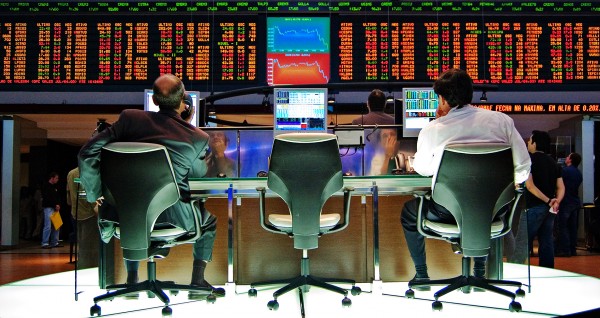 Both the financial and goods markets are heavily influenced by sentiment. And such sentiment tends to be self-reinforcing. If consumers and investors are pessimistic, they will not spend and not invest. The economy declines and this further worsens sentiment and further discourages consumption and investment. Banks become less willing to lend and stock markets fall. The falling stock markets discourage people from buying shares and so share prices fall further. The despondency becomes irrational and greatly exaggerates economic fundamentals.
Both the financial and goods markets are heavily influenced by sentiment. And such sentiment tends to be self-reinforcing. If consumers and investors are pessimistic, they will not spend and not invest. The economy declines and this further worsens sentiment and further discourages consumption and investment. Banks become less willing to lend and stock markets fall. The falling stock markets discourage people from buying shares and so share prices fall further. The despondency becomes irrational and greatly exaggerates economic fundamentals.
This same irrationality applies in a boom. Here it becomes irrational exuberance. A boom encourages confidence and stimulates consumer spending and investment. This further stimulates the boom via the multiplier and accelerator and further inspires confidence. Banks are more willing to lend, which further feeds the expansion. Stock markets soar and destabilising speculation further pushes up share prices. There is a stock market bubble.
 But bubbles burst. The question is whether the current global stock market boom, with share prices reaching record levels, represents a bubble. One indicator is the price/earnings (PE) ratio of shares. This is the ratio of share prices to earnings per share. Currently the ratio for the US index, S&P 500, is just over 26. This compares with a mean over the past 147 years of 15.64. The current ratio is the third highest after the peaks of the early 2000s and 2008/9.
But bubbles burst. The question is whether the current global stock market boom, with share prices reaching record levels, represents a bubble. One indicator is the price/earnings (PE) ratio of shares. This is the ratio of share prices to earnings per share. Currently the ratio for the US index, S&P 500, is just over 26. This compares with a mean over the past 147 years of 15.64. The current ratio is the third highest after the peaks of the early 2000s and 2008/9.
An alternative measure of the PE ratio is the Shiller PE ratio (see also). This is named after Robert Shiller, who wrote the book Irrational Exuberance. Unlike conventional PE ratios, which only look at average earnings over the past four quarters, the Shiller PE ratio uses average earnings over the past 10 years. “Because this factors in earnings from the previous ten years, it is less prone to wild swings in any one year.”
 The current level of the Shiller PE ratio is 29.14, the third highest on record, this time after the period running up to the Wall Street crash of 1929 and the dot-com bubble of the late 1990s. The mean Shiller PE ratio over the past 147 years is 16.72.
The current level of the Shiller PE ratio is 29.14, the third highest on record, this time after the period running up to the Wall Street crash of 1929 and the dot-com bubble of the late 1990s. The mean Shiller PE ratio over the past 147 years is 16.72.
So are we in a period of irrational exuberance? And are stock markets experiencing a bubble that sooner or later will burst? The following articles explore these questions.
Articles
2 Clear Instances of Irrational Exuberance Seeking Alpha, Jeffrey Himelson (12/2/17)
Promised land of Trumpflation-inspired global stimulus has been slow off the mark South China Morning Post, David Brown (20/2/17)
A stock market crash is a way off, but this boom will turn to bust The Guardian, Larry Elliott (16/2/17)
The “boring” bubble is close to bursting – the Unilever bid proves it MoneyWeek, John Stepek (20/2/17)
Questions
- Find out what is meant by Minksy’s ‘financial instability hypothesis’ and a ‘Minsky moment’. How might they explain irrational exuberance and the sudden turning point from a boom to a bust?
- Is it really irrational to buy shares with a very high PE ratio if everyone else is doing so?
- Why are people currently exuberant?
- What might cause the current exuberance to end?
- How does irrational exuberance affect the size of the multiplier?
- How might the behaviour of banks and other financial institutions contribute towards a boom fuelled by irrational exuberance?
- Compare the usefulness of a standard PE ratio with the Shiller PE ratio.
- Other than high PE ratios, what else might suggest that stock markets are overvalued?
- Why might a company’s PE ratio differ from its price/dividends ratio (see)? Which is a better measure of whether or not a share is overvalued?
 With the Conservatives having lost their majority in Parliament in the recent UK election, there is renewed discussion of the form that Brexit might take. EU states are members of the single market and the customs union. A ‘hard Brexit’ involves leaving both and this was the government’s stance prior to the election. But there is now talk of a softer Brexit, which might mean retaining membership of the single market and/or customs union.
With the Conservatives having lost their majority in Parliament in the recent UK election, there is renewed discussion of the form that Brexit might take. EU states are members of the single market and the customs union. A ‘hard Brexit’ involves leaving both and this was the government’s stance prior to the election. But there is now talk of a softer Brexit, which might mean retaining membership of the single market and/or customs union. on a country-by-country basis. Goods imported from outside the EU are charged tariffs in the country of import and can then be sold freely around the EU with no further tariffs.
on a country-by-country basis. Goods imported from outside the EU are charged tariffs in the country of import and can then be sold freely around the EU with no further tariffs.









